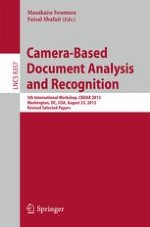This book constitutes the thoroughly refereed post-workshop proceedings of the 5th International Workshop on Camera-Based Document Analysis and Recognition, CBDAR 2013, held in Washington, DC, USA, in August 2013. The 14 revised full papers presented were carefully selected during two rounds of reviewing and improvement from numerous original submissions. Intended to give a snapshot of the state-of-the-art research in the field of camera based document analysis and recognition, the papers are organized in topical sections on text detection and recognition in scene images and camera-based systems.
